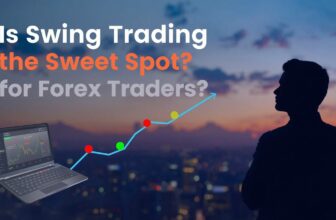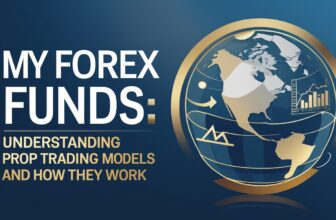
Welcome to the intricate world of Forex dynamics. Delve into the enigmatic concept of smart money. This guide demystifies its role, impact, and strategies, empowering traders to navigate the markets with insights from institutional influences.
Smart money in Forex refers to large institutional traders and banks influencing markets. Understanding their moves aids traders; following their positions may signal potential market directions for informed trading decisions.
Key Takeaways:
- The concept of smart money in forex involves understanding the role of market makers and their ability to manipulate the market.
- Institutional investors and professional traders are considered smart money traders who use their knowledge and resources to make informed trading decisions.
- Smart money traders analyse market structure, monitor indicators, and study the activities of other market participants to identify potential profitable opportunities.
- By understanding the smart money concept in forex, traders can develop effective trading strategies and improve their chances of success in the forex market.
- Effective risk management is crucial when trading in the forex market to protect against potential losses.
What is Smart Money Concept in Forex
Market making is a crucial aspect of the securities industry, where specialised entities known as market makers provide liquidity by committing capital. These market makers play a unique role in the forex market by crossing clients’ orders, participating in price-setting mechanisms, and ensuring there is sufficient liquidity. The business of market making is not just about executing trades but also about balancing supply and demand to create efficient markets.
Understanding the concept of smart money in forex involves recognising the role of market makers and their ability to manipulate the market. Smart money traders, such as institutional investors and professional traders, use their knowledge and resources to make informed decisions and take advantage of market inefficiencies. They analyse market structure, monitor indicators, and study the activities of other market participants to identify potential profitable opportunities. By understanding the smart money concept in forex, traders can develop effective trading strategies and improve their chances of success in the forex market.
Smart money represents capital strategically invested by institutional investors, market mavens, central banks, funds, and seasoned financial professionals. Unlike retail investors, these entities are perceived to possess a fuller understanding of the market or exclusive information, providing them with a higher chance of success.
Smart money is essentially the capital controlled by astute financial professionals, renowned for their expertise and success in the speculative markets. Originating from a gambling term denoting successful bets, the smart money concept suggests that these investments are strategically placed to generate higher returns. The divergence of trading patterns between institutional investors and retail traders adds to the allure of smart money. Supposedly, the strategies of these market-savvy entities can provide retail traders with a competitive edge in the forex market.
The Driving Force: Central Banks and Market Makers
In forex trading, the dynamics of smart money are intricately woven with the actions of central banks and market makers. Understanding the symbiotic relationship between these entities is crucial for understanding the driving force behind smart money movements.
Central Banks: Shaping Smart Money with Economic Forces
Central banks play a pivotal role in shaping smart money movements. One of the primary tools at their disposal is interest rates. For instance, when a central bank decides to raise interest rates, it can attract foreign capital seeking higher returns. This influx of capital is a significant force behind smart money. Additionally, institutional investors strategically position themselves to benefit from these interest rate differentials.
Example: The Bank of England’s Interest Rate Policy
Consider the Bank of England’s decision to increase interest rates. In response, institutional investors may shift their capital into British assets, anticipating higher yields. This strategic move creates a ripple effect, influencing smart money movements and impacting the forex market.
Market Makers: Orchestrating Liquidity and Influencing Trends
Market makers, often financial institutions or brokerage firms, act as facilitators by providing liquidity to the forex market. Their role extends beyond mere facilitation; market makers actively participate in trading, influencing the supply and demand dynamics. In the context of smart money, these entities are considered key players whose actions can significantly impact market trends.
Example: Role of Investment Banks as Market Makers
Major investment banks, like Goldman Sachs or JPMorgan, function as market makers in the forex realm. Through their substantial trading volumes, these banks not only facilitate transactions but also strategically position themselves in the market. This creates a powerful force that can move markets and influence trading sentiments.
Collaborative Forces: Central Banks and Market Makers in Sync
The synergy between central banks and market makers amplifies the influence of smart money in the forex market. Central banks’ macroeconomic policies can entice market makers to align their strategies with the prevailing economic conditions. When central banks signal a shift in monetary policy, market makers respond by adjusting their positions. This creates a harmonized force that shapes smart money movements.
Example: Quantitative Easing Impact
During periods of quantitative easing, where central banks inject liquidity into the financial system, market makers may strategically position themselves. This positioning is so that they can benefit from increased market activity. This collaboration between central banks and market makers becomes a driving force behind smart money.
Impact on Retail Traders: Riding the Coattails of Smart Money
Understanding the driving force behind smart money is not only insightful for institutional investors but also for retail traders. As central banks and market makers orchestrate their moves, retail traders can gain a competitive edge by aligning their strategies with the prevailing smart money trends. Recognizing the impact of interest rate decisions, liquidity injections, and market maker activities allows retail traders to make informed decisions.
Smart Money Concepts Trading Strategy: A Modern Approach to Price Action
The Smart Money Concepts (SMC) trading strategy has emerged as a groundbreaking approach, reshaping traditional notions of price action. SMC represents a paradigm shift from conventional terminology, introducing novel concepts to redefine how traders interpret market dynamics.
Origins and Influencers
The roots of the Smart Money Concepts trading strategy trace back to the teachings of Michael J. Huddleston, also known as The Inner Circle Trader. Huddleston is credited with pioneering the concepts that form the basis of SMC. Concepts that have revolutionized how traders perceive and engage with price action. The strategy gained traction through online forex forums, where traders sought to understand and implement Huddleston’s innovative approach.
At the core of SMC is the abandonment of traditional forex terminology. Concepts such as supply and demand, support and resistance, and price patterns are replaced with terms like “liquidity grabs” and “mitigation blocks.” For instance, an order block in SMC serves as a substitute for the supply or demand an asset experiences in traditional analysis. This departure from established terminology aims to offer traders a fresh perspective on market dynamics.
The terminology may initially seem foreign. But, a closer examination reveals that SMC is, in essence, a more refined version of classical trading strategies. Traders operating within the SMC framework still rely on fundamental concepts like supply and demand, price patterns, and support and resistance. However, under different names. Understanding SMC involves understanding terms such as “breaker blocks” (traditional support and resistance). Another term is, “fair value gaps” (imbalances in the market).
Liquidity Grabs, Mitigation Blocks: Understanding the SMC Terminology
To illustrate, a liquidity grab in SMC is like identifying a surge in market activity. This is where institutions or market makers create liquidity imbalances. Traders leveraging SMC principles would interpret this as a strategic move by smart money entities. Similarly, mitigation blocks, replacing support and resistance, are areas on a chart where institutions are expected to step in. This way, the impact of price movements is mitigated. These examples underscore the unique vocabulary that defines the SMC trading strategy.
More than just a trading strategy, SMC represents a comprehensive philosophy about how financial markets operate. It posits that market makers engage in manipulative practices that can be deciphered and leveraged by retail traders. By aligning trading strategies with the supposed actions of smart money, SMC traders believe they can gain a competitive edge in the market.
Controversies Surrounding SMC
While SMC has gained popularity, it is not without controversy. Skeptics argue that the theory behind SMC is flawed. In particular, in attributing certain market patterns to manipulations by smart money actors. The lack of concrete evidence supporting these claims has led to debates within the trading community. Critics emphasize the importance of approaching SMC with a critical mindset and demand robust evidence before fully embracing its principles.
The evolution of the Smart Money Concepts trading strategy marks a significant departure from traditional forex approaches. While the controversy surrounding SMC persists, its influence on how traders interpret and navigate the forex landscape cannot be denied.
Understanding Smart Money Manipulation and Indicators in Forex
Smart money manipulation is a significant factor in the forex market, where institutional investors and other large market participants have the power to control or influence the price of financial instruments. These players strategically accumulate or distribute large positions, creating artificial price movements that can deceive retail traders. To navigate this manipulation, traders need to understand and analyze various indicators and techniques.
One essential indicator in smart money forex analysis is volume analysis. By monitoring the volume of trades, traders can gain insights into the activities of institutional investors and detect potential market manipulations. Additionally, order flow analysis helps traders understand the direction and speed at which orders are being executed and gives an indication of market sentiment.
Market depth analysis is another crucial tool that smart money traders utilize. By examining the limit orders placed at various price levels, traders can identify areas of supply and demand imbalances, enabling them to anticipate potential market movements. Price action patterns, such as support and resistance levels, also provide valuable insights into the smart money’s activities and their impact on price dynamics.
Example of Smart Money Indicators in Forex:
“Volume analysis is a primary tool in my trading strategy. By monitoring the volume of trades and comparing it to historical data, I can identify when smart money is entering or exiting the market. This information allows me to make informed trading decisions and capitalize on price movements caused by institutional investors.” – Experienced Forex Trader
Smart money forex signals also play a crucial role in understanding market manipulation. These signals provide valuable information about potential market movements, allowing traders to align their strategies accordingly for better profitability. However, it is important to note that signals should be used as a complement to a trader’s own analysis, rather than relying solely on them.
By understanding smart money manipulation and utilizing appropriate indicators and analysis techniques, traders can gain insights into market dynamics and enhance their chances of success in the forex market.
| Smart Money Indicators | Description |
|---|---|
| Volume Analysis | Monitoring trade volume to gain insights into institutional investors’ activities and potential market manipulations. |
| Order Flow Analysis | Understanding the direction and speed of order execution to gauge market sentiment. |
| Market Depth Analysis | Analyzing limit orders at different price levels to identify supply and demand imbalances. |
| Price Action Patterns | Studying support and resistance levels to detect the impact of smart money activities on price dynamics. |
| Smart Money Forex Signals | Providing valuable information about potential market movements for traders to align their strategies accordingly. |
The Importance of Smart Money in Forex Trading and Risk Management
The concept of smart money plays a crucial role in the forex market, providing traders with valuable insights and opportunities to improve their trading strategies. Smart money traders, including institutional investors and professional traders, have access to resources and information that give them an edge in the market. By studying the activities of smart money players and the market structure, traders can identify trends and patterns that can be used to their advantage.
One of the key benefits of understanding smart money in forex is the ability to incorporate smart money indicators into trading strategies. These indicators, such as volume analysis and market depth, provide valuable insights into market sentiment and potential market movements. By analyzing these indicators, traders can make informed decisions and align their strategies with the activities of smart money players.
While smart money can provide significant opportunities, it is important for traders to implement effective risk management strategies. This involves setting stop-loss orders to limit potential losses, diversifying portfolios to spread risk, and avoiding emotional trading decisions. By following these risk management principles, traders can protect their capital and minimize potential losses in the volatile forex market.
In conclusion, understanding the importance of smart money in forex trading is essential for traders looking to improve their trading performance. By analyzing the activities of smart money players, incorporating smart money indicators, and implementing effective risk management strategies, traders can increase their chances of success in the forex market and achieve their financial goals.
FAQ
What is smart money in forex?
Smart money in forex refers to institutional investors and professional traders who have access to resources and information that retail traders may not have. They use their knowledge and resources to make informed trading decisions and take advantage of market inefficiencies.
What is the role of market makers in the forex market?
Market makers are specialized entities that provide liquidity in the securities industry. In the forex market, they cross clients’ orders, participate in price-setting mechanisms, and ensure there is sufficient liquidity. They play a crucial role in creating efficient markets and balancing supply and demand.
How do smart money traders manipulate the forex market?
Smart money traders have the means to control or influence the price of a financial instrument. They may accumulate or distribute large positions strategically, causing price fluctuations that can be used to their advantage. They also rely on various indicators and analysis techniques to evaluate the market and identify potential trading opportunities.
What indicators do smart money traders use in forex?
Smart money traders use various indicators such as volume analysis, order flow, market depth, and price action patterns to evaluate the market. These indicators provide insights into the activities of smart money players and can help traders make informed trading decisions.
Why is understanding smart money important for forex traders?
Understanding smart money is crucial for forex traders as it helps them understand the dynamics of the market and make informed trading decisions. It allows traders to identify trends, reversals, and other price patterns that can be used to their advantage. Additionally, incorporating smart money indicators into trading strategies provides insights into market sentiment and potential market movements.
How can traders manage risks when trading in the forex market?
Traders can manage risks effectively in the forex market by following risk management principles. This may include setting stop-loss orders, diversifying portfolios, and avoiding emotional trading decisions. Managing risks is important to protect capital and improve overall trading performance.

















